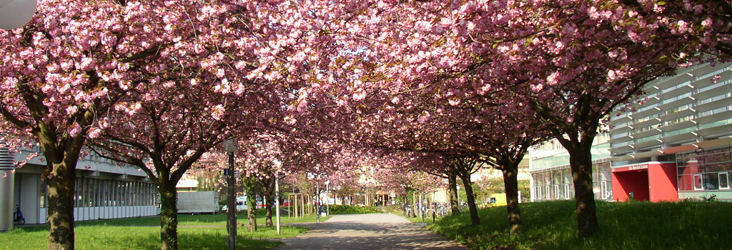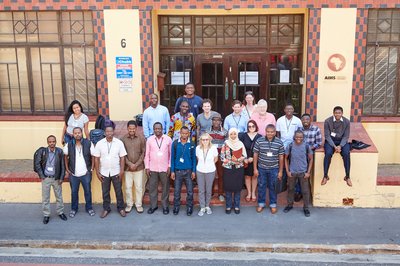
Newsroom
The IWR is an interdisciplinary research center for Scientific Computing which builds bridges across disciplines. It promotes mathematical and computational methods in science, engineering and the humanitites. Currently the IWR comprises more than 50 research teams from various faculties. Around 600 scientists work together in interdisciplinary cooperation projects. In addition to educating the next generation of excellent scientists the IWR also focuses on advacing international research networks.
2017
October 30, 2017
Making cancer more predictable
For his research and his outstanding work on the temporal development of diseases Dr. Marcel Mohr was awarded with the annual Klartext-Preis 2017 in mathematics
Under the supervision of Prof. Dr. Anna Marciniak-Czochra and in cooperation with the two physicians Dr. Dirk Hose and Dr. Anja Seckinger from the laboratory for research on myeloma, Dr. Marcel Mohr explored how mathematics can make a contribution to medicine with direct benefits for the patients. More precisely Mohr refined a growth model, which calculates the temporal development and the progress of cancer.
Besides benign plasma cells, cancer patients also develop malignant cells, which suppress the benign cells. This proceeds in different tempos, depending on the doubling time of the patient´s malign cells. Marcel Mohr´s model of growth is essential in the sense that it is not restricted to an exponential model but also takes other components into account (e.g., the interaction between benign and malign plasma cells). Calculations with real patients’ data revealed that this advanced model predicts the ongoing development of the disease very precisely, and thus it is able to open doors for new treatment approaches.
July 12, 2017
IWR in collaboration with AIMS conducts summer school in Cape Town
The summer school on Mathematical Modelling and Scientific Computing, jointly organized by the Universität Heidelberg and the African Institute for Mathematical Sciences (AIMS) was conducted in Cape Town, South Africa from 13th to 17th February 2017.
The workshop conducted in a highly interactive and well-organized manner, facilitated the training of participants with updated research methods and techniques such as the application of an optimal control, parameter estimation and simulation as well as numerical simulations with the finite element method. The workshop fostered exchange of new scientific knowledge among the top scholars of the field from Africa and Europe as well as provided opportunity for the students to interact with their fellow students from other African countries.
Participants found the skills acquired at the workshop highly beneficial. Teaching on the Finite Element Methods, one of the core concept for the numerical solution of PDE, was especially mentioned by many participants as one of the most important and influential topics of this summer school. To read more about the experiences of our participants, click here.
Report by: Namia Akhtar
July 8, 2017
Tag der offenen Tür
"Mathematik, Informatik und Scientific Computing zum Anfassen"
Am 8. Juli laden die Fakultät für Mathematik & Informatik und das Interdisziplinäre Zentrum für Wissenschaftliches Rechnen (IWR) gemeinsam zum Tag der Offenen Tür im Mathematikon der Universität Heidelberg ein. Von Mathematik zum Anfassen über Forschung zu Künstlicher Intelligenz bis zum Robotiklehrlabor - Wissenschaftler geben spannende Einblicke in die Forschung und Praxis rund um Mathematik, Informatik und Scientific Computing. Führungen durch das neueste Gebäude der Universität Heidelberg ergänzen das abwechslungsreiche Programm.
Eine Auswahl an Speisen und Getränken wird durch die Fachschaft MathPhys angeboten.
Der Eintritt ist frei.
July, 2017
Modern ways to document ancient objects
Cameras, drones and laser scanning – ArchEyeAutomatic summer school taking place
From 26th to 28th July the Interdisciplinary Center for Scientific Computing and the Institute for technical Informatics of Heidelberg University host the summer school “Cameras, Drones and Laser Scanning” at the UNESCO World Heritage Site Lorsch Abbey. The main focus is how digital methods can be used to document excavations, buildings and small finds 3D.
Christian Seitz, who works in Prof. Dr. Katja Mombaur´s work group “Optimizations, robotics and biomechanics” at Heidelberg University emphasizes that the digital preservation and documentation of finds is a key skill for archeologists, independent of their research area. In the course of the event the participants (especially researchers from archeology, art history, geography, informatics and robotics) can try out the drones and laser scans on the abbey´s grounds and afterwards evaluate the results and measurements. Therefore, the event is a great possibility to collect theoretical knowledge and practical experiences in dealing with those research tools.
[Press release Heidelberg University]
[Summer school Lorsch - Webpage]
June 22, 2017
Simulation technologies for city planning
13th Modellierungstag Rhein-Neckar
On 22nd June representatives of different research facilities and partners from industry gathered to the 13th Modellierungstag. The topic of “Urban simulation technologies” addresses the question how central processes concerning the city planning can be organized with the help of models and scientific computing. Organisers are the Heidelberg Graduate School of Mathematical and Computational Methods for the Sciences (HGS MathComp), the InnovationLab GmbH and BASF SE Ludwigshafen.
Dr. Michael J. Winckler, executive director of the HGS MathComp, explains that a functioning city in the 21th century is dependent on model-based planning in several areas, e.g. road construction. Those individual models collect data on relevant agents and elements, e.g. traffic participants, simulate their changes and optimize their processes. At the modeling day scientists come together to exchange new ideas and to discuss the upcoming developments.
May 02, 2017
Second woman receiving the PRACE Award
Prof Dr. Frauke Gräter awarded by PRACE Ada Lovelace Award 2017
Congratulations to IWR member Frauke Gräter, Heidelberg Institute for Theoretical Studies (HITS), Heidelberg University, being awarded with the PRACE Award 2017. With her outstanding impact on HPC research, Frauke Gräter is the second female scientist being acknowledged with the PRACE award.
May, 2017
Promoting e-learning in mathematics
The mathematical department of Heidelberg University being nominated for the Landeslehrpreis 2017 with its concept by Dr. Vogel for an e-learning platform
E-learning concepts have the potential to support students in their individual learning process, which is particularly important for math-students, due to the high dropout rate in this subject (up to 50%). By now such e-learning-concepts are not widespread due to the disability to meet the special requirements of the specific learning process in mathematics. The project called MaMpf (Mathematische Medienplattform), created by Dr. Denis Vogel, Heidelberg University, can change this and help math students to make aspects of understanding and learning more temporally flexible and to strengthen the self-determined learning.
One of the sub-projects of MaMpf was already applied to record a lecture. But the recording of lectures is not the only advantage of the project. MaMpf also provides the students with interactive documents to comprehend and reproduce the contents of the lecture and with self-tests to check their own learning process. The crucial point of MaMpf is the cross-linking between these several sub-projects.

May 2017
Jörg Langowski (1955 - 2017)
The Interdisciplinary Center for Scientific Computing is deeply saddened by the news of Jörg Langowski’s passing. We have lost an exceptional scientist, treasured colleague and dear friend.
Our deepest sympathies go out to his family during this difficult time.
March 28, 2017
Professors Kanschat and Gertz fellows in the 10th class of the Marsilius-Kolleg
Congratulations to our venerable IWR-members, Prof. Dr. Guido Kanschat and Prof. Dr. Michael Gertz on their fellowship in the Marsilius-Kolleg of 2017.
It’s our privilege to announce the participation of our esteemed professors Michael Gertz and Guido Kanschat in the 2017 fellow class of the Marsilius Kolleg, Heidelberg University. Until March 2018 they will pioneer interdisciplinary research projects and participate in discussions. In their regular meetings, they will devote themselves to topics like the treatment of chronic diseases with methods that are located beyond the clinical approach. Furthermore they will focus on analyzing aspects of stress management from various approaches, including the disciplines of behavioral economics, psychology and neuroscience.
Directed by Prof. Dr. Thomas Rausch and Prof. Dr. Bernd Schneidmüller, the Marsilius Kolleg is a cornerstone within Heidelberg’s Excellence Initiative. It is geared towards the junction of distinguished academics and expediting the interconnected, interdisciplinary dialogue of the humanities, natural, social and life sciences and thus meets the focus of the IWR in every respect.
March 16, 2017
Hamprecht and his researchers develop a new algorithm for analysing image data
The working group "Image Analysis and Learning", lead by Prof Dr Fred Hamprecht, is advancing research towards a circuit diagram of the brain
"Understanding how the brain works is one of science's greatest mysteries. "Except for a simple roundworm, there is still no circuit diagram of a complete animal brain, let alone a human brain," states Prof. Hamprecht. In recent years, imaging techniques have been developed that can finally produce three-dimensional images of the entire brain at a sufficiently high resolution. These images are so big, however, that manual analysis would take centuries. What is needed, therefore, is an automated analysis process with the lowest possible error rate. [...]
In the latest partitioning challenge, the CREMI Challenge on Circuit Reconstruction from Electron Microscopy Images, the researchers at the Interdisciplinary Center for Scientific Computing succeeded in producing the most accurate analysis by a large margin. [...]
To explain the challenge of using this analysis method to produce a circuit diagram of a brain, Prof. Hamprecht resorts to the fly as an example. The Heidelberg team is using their new algorithm to map the brain circuit of the fly first before moving on to higher animals, according to mathematician Dr Anna Kreshuk."
March 13, 2017
Prof Mombaur’s robotics going public on SWR1 Baden-Württemberg
Making her work more accessible to the general population, Prof Mombaur recently presented her research on humanoid robots within the broadcasting program on SWR1
On March 9, 2017, Prof Mombaur, the leading robotics expert at the Interdisciplinary Center for Scientific Computing, was interviewed by Nicole Köster, on SWR1. In her 30 min interview, Mombaur presented her latest research, discussing, for example the challenges of the progressive motion by humanoid robots. Focusing the research on the comprehension of human movement, Mombaur envisions intelligent medical applications in prosthetics and application areas that prove to be life-threatening, such as fire fighting and mine sweeping.
